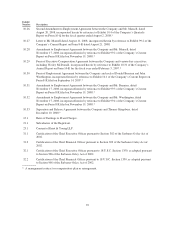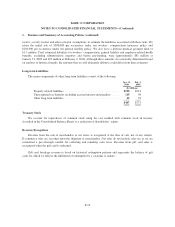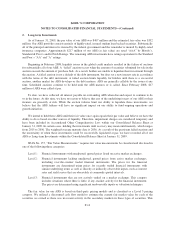Kohl's 2008 Annual Report Download - page 46
Download and view the complete annual report
Please find page 46 of the 2008 Kohl's annual report below. You can navigate through the pages in the report by either clicking on the pages listed below, or by using the keyword search tool below to find specific information within the annual report.KOHL’S CORPORATION
NOTES TO CONSOLIDATED FINANCIAL STATEMENTS
1. Business and Summary of Accounting Policies
Business
As of January 31, 2009, Kohl’s Corporation operated 1,004 family-oriented department stores that feature
private, exclusive and national brand apparel, footwear, accessories, soft home products and housewares targeted
to middle-income customers. Our stores are located in 48 states.
Our authorized capital stock consists of 800 million shares of $0.01 par value common stock and 10 million
shares of $0.01 par value preferred stock.
Consolidation
The consolidated financial statements include the accounts of Kohl’s Corporation and its subsidiaries. All
intercompany accounts and transactions have been eliminated.
Accounting Period
Our fiscal year ends on the Saturday closest to January 31. Unless otherwise noted, references to years in
this report relate to fiscal years, rather than to calendar years. Fiscal year 2008 (“2008”) ended on January 31,
2009 and was a 52-week year. Fiscal year 2007 (“2007”) ended on February 2, 2008 and was a 52-week year.
Fiscal year 2006 (“2006”) ended on February 3, 2007 and was a 53-week year.
Use of Estimates
The preparation of consolidated financial statements in conformity with accounting principles generally
accepted in the United States (“GAAP”) requires management to make estimates and assumptions that affect the
amounts reported in the consolidated financial statements and accompanying notes. Actual results could differ
from those estimates.
Reclassifications
Certain reclassifications have been made to prior years’ Consolidated Statements of Cash Flows to conform
to the 2008 presentation.
Cash
Credit and debit card receivables included within cash were $71 million at January 31, 2009 and $76 million
at February 2, 2008.
Investments
Short-term investments are stated at cost, which approximates market. Short-term investments include
investments in money-market funds and commercial paper at January 31, 2009 and investments in auction rate
securities (“ARS”) at February 2, 2008. Long-term investments as of January 31, 2009 consist of ARS
investments which are classified as available-for-sale securities and recorded at market.
Merchandise Inventories
Merchandise inventories are valued at the lower of cost or market with cost determined on the first-in,
first-out (“FIFO”) basis using the retail inventory method (“RIM”). Under RIM, the valuation of inventory at cost
F-7
























